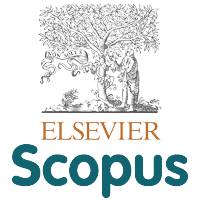Nutrient Content in Ylang-Ylang (Cananga odorata (Lam.) Hook.f. & Thoms., Annonaceae) Cultivated in Ecuador
Abstract
Keywords
Full Text:
PDFReferences
Benini, C., Danflous, J. P., Wathelet, J. P., Jardin, P., & Fauconnier, M. L. (2010). L'ylang-ylang [Cananga odorata (Lam.) Hook.f. & Thomson]: une plante à huile essentielle méconnue dans une filière en danger. Biotechnologie, Agronomie, Société et Environnement, 14(4). 693-705. PDF
Medel-Jiménez, F., Piringer, G., Gronauer, A., Barta, N., Neugschwandtner, R. W., Krexner, T., & Kral, I. (2022). Modelling soil emissions and precision agriculture in fertilization life cycle assessment - A case study of wheat production in Austria. Journal of Cleaner Production, 380(2), 134841. DOI
Bickford, A., & Martínez, R. (2021). Ylang Ylang, Cananga odorata. Agexport. PDF
Castro, H. E. (1996). Bases técnicas para el conocimiento y manejo de los suelos del valle cálido del Alto Magdalena. AGROSAVIA. website
Furcal-Beriguete, P. (2017). Nutrient extraction by cocoa fruits in two locations in Costa Rica. Agronomía Mesoamericana, 28(1), 113-129. DOI
Galvão Novaes, C., Almeida Bezerra, M., Paranhos da Silva, E. G, Pinto dos Santos, A. M., da Silva Romao, I. L., & Santos Neto, J. H. (2016). A review of multivariate designs applied to the optimization of methods based on inductively coupled plasma optical emission spectrometry (ICP OES). Microchemical Journal, 128, 331-346. DOI
Guayaquil canton government (2021). Plan de desarrollo y ordenamiento territorial (PDOT) del cantón Guayaquil. PDF
Hernández, S. (2013). Efecto de los insumos organicos aplicados en plantulas de guanabana (Annona muricata L.) en la produccion de fenoles totales. website
Kalagatur, N. K., Mudili, V., Kamasani, J., & Siddaiah, C. (2018). Discrete and combined effects of Ylang-Ylang (Cananga odorata) essential oil and gamma irradiation on growth and mycotoxins production by Fusarium graminearum in maize. Food Control, 94, 276-283. DOI
Kuspradini, H., Putri, A. S., Sukaton, E., & Mitsunaga, T. (2016). Bioactivity of Essential Oils from Leaves of Dryobalanops lanceolata, Cinnamomum burmannii, Cananga odorata, and Scorodocarpus borneensis. Agriculture and Agricultural Science Procedia, 9, 411-418. DOI
LaCroix, R. L., Keeney, D. R., & Walsh, L. M. (1970). Potentiometric titration of chloride in plant tissue extracts using the chloride ion electrode. Communications in Soil Science and Plant Analysis, 1(1), 1-6. DOI
Manner, H. I., & Elevitch, C. R. (2006). Cananga odorata (ylang-ylang) in C. Elevitch (Ed.), Traditional Trees of Pacific Islands: their Culture, Environment, and Use. Permanent Agriculture Resources. PDF
Muñoz-Huerta, R. F., Guevara-González, R. G., Contreras-Medina, L. M., Torres-Pacheco, I., Prado-Olivares, J., & Ocampo-Velazquez, R. V. (2013). A Review of Methods for Sensing the Nitrogen Status in Plants: Advantages, Disadvantages and Recent Advances. Sensors, 13, 10823-10843. DOI
Nurhayani, F. O., Wulandari, A. S., & Suharsi, T. K. (2019). The Floral Morphology and Anatomy of Kenanga (Cananga odorata (Lam.) Hook.f. & Thomson). IOP Conference Series: Earth and Environmental Science, 394, 012034. DOI
Ojha, S., Chakraborty, M. R., Dutta, S., & Chatterjee, N. C. (2008). Influence of VAM on Nutrient Uptake and Growt of Custard-apple. Asian Journal of Experimental Sciences, 22(3), 221-224. website
Parrota, J. A. (2014). Cananga odorata in A. Roloff, H. Weisgerber, U. M. Lang, B. Stimm and P. Schütt (Eds.), Enzyklopädie der Holzgewächse: Handbuch und Atlas der Dendrologie (pp. 1-8). Wiley-VCH Verlag GmbH & Co. DOI
Passos, V. M., Santana, N. O., Gama, F. C., Oliveira, J. G., Azevedo, R. A., & Vitória, A. P. (2005). Growth and ion uptake in Annona muricata and A. squamosa subjected to salt stress. Biologia Plantarum, 49(1), 285-288. DOI
Putri, D. K. Y., Dewi, I. E. P., Kusuma, H. S., & Mahfud, M. (2019). Extraction of an essential oil from fresh Cananga flowers (Cananga odorata) using solvent-free microwave method. Journal of Chemical Technology and Metallurgy, 54(4), 793-802. PDF
Rahayu, S., Kartono, A. P., Basuni, S., & Hikmat, A. (2020). Dominance, association and distribution patter of tree species in burnt forest in east Kalimantan. Biotropia, 28(1), 29-37. DOI
Rahman, M. M., Lopa, S. S., Sadik, G., Rashid, H. O., Islam, R., Khondkar, P., Alam, A., & Rashid, M. A. (2005). Antibacterial and cytotoxic compounds from the bark of Cananga odorata. Fitoterapia 76(7-8), 758-761. DOI
Syed Ismail, S.N.A., Syed Soffian, S.S., Aziz, R.A., & Tahiruddin, N.S.M. (2020). Antibacterial and Insect-Repellent Activities of Cananga odorata Essential Oil. In: N. Alias, R. Yusof (Eds.), Charting the Sustainable Future of ASEAN in Science and Technology. Springer. DOI
Tan, L. T. H., Lee, L. H., Yin, W. F., Chan, C. K., Kadir, H. A., Chan, K. G., & Goh, B. H. (2015). Traditional uses, Phytochemistry, and Bioactivities of Cananga odorata (Ylang-Ylang). Evidence-Based Complementary and Al ternative Medicine, 2015, 896314. DOI
Upadhyay, N., Singh, V. K., Dwivedy, A. K., Chaudhari, A. K., & Dubey, N. K. (2021). Assessment of nanoencapsulated Cananga odorata essential oil in chitosan nanopolymer as a green approach to boost the antifungal, antioxidant and in situ efficacy. International Journal of Biological Macromolecules 171, 480-490. DOI
Vidal, L., Sánchez, G., Vidal, N., Castillo D., & Chiquito, G. (2014). Análisis de suelo y foliar en guanábano (Annona muricata L.) en Blanca Espuma Municipio de Alto Lucero, Veracruz. Revista Brasileira de Fruticultura, 36(e1), 157-165. DOI
DOI: http://doi.org/10.17503/agrivita.v45i3.4015
Copyright (c) 2023 The Author(s)

This work is licensed under a Creative Commons Attribution-NonCommercial 4.0 International License.








